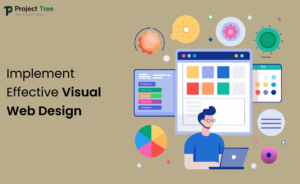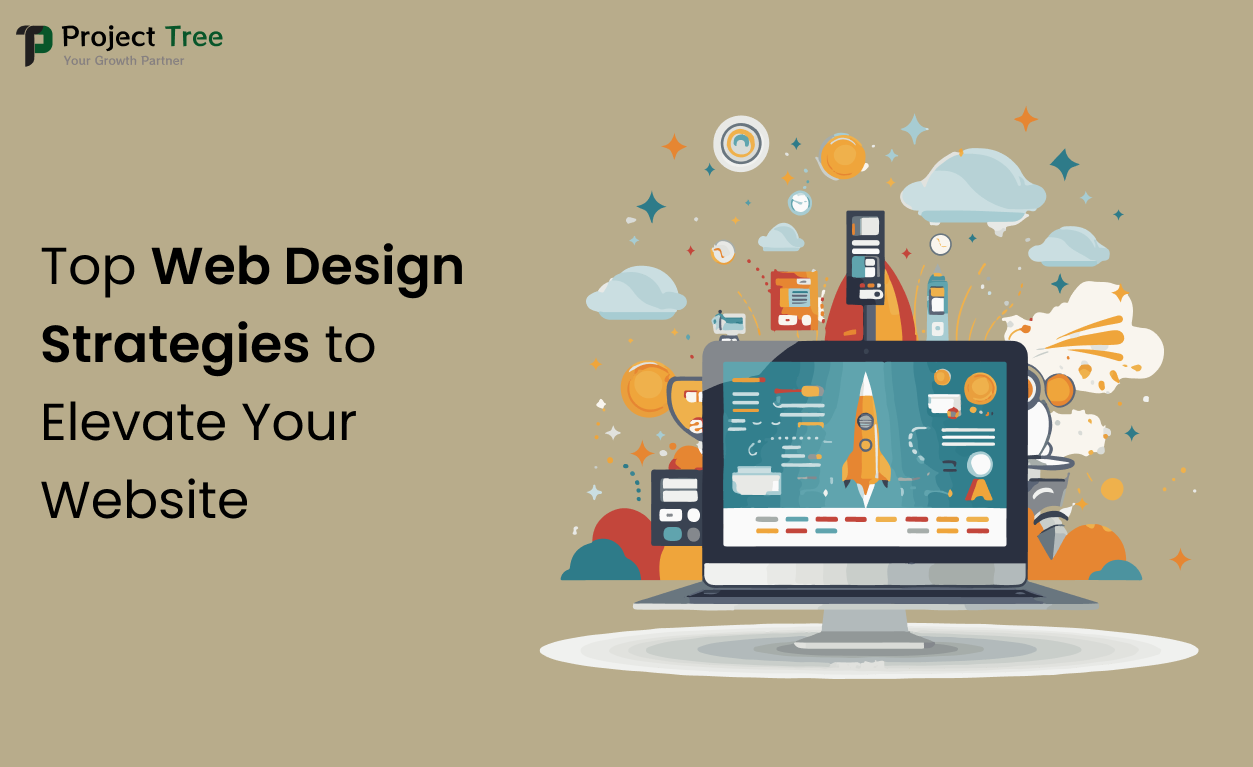Considering the online presence as one of the essential aspects of every business, it becomes critical for today’s company to have a perfect web design. As business become more concentrated online and the users get wiser, it sure helps to differentiate oneself from the rest. Blending your website includes more than the appearance; it entails using a compelling strategy that aims to improve convection to enhance its form and functionality. So let’s look into the most popular web design trends, that can help achieve these goals, and most importantly – use actual tools and solutions.
1. Prioritize User Experience (UX)
Implementing user experience to a site is one of the key characteristics of a good site. UX design carries the message of understanding your users and guiding them through your site’s interface without the feeling of helplessness. Here’s how to prioritize UX: Here’s how to prioritize UX:
Simple Navigation:
Make sure your links are easily seen and logical; do not make your visitors guess where each link leads. Label your menu well, using descriptive words; make it possible to access most of the key info and pages within two or three clicks at most. Other forms of navigation include drop-down menus and breadcrumb trails.
Responsive Web Design:
The use of MO devices in accessing websites is on the rise; therefore, having a responsive website design is essential. Responsive AI web design helps your website to be fully functional and properly designed and developed to fit a range of screen sizes including desktop, tablet, and mobile screen sizes. This adaptability can enhance usability which can increase the rank of your site in search engine results.
Fast Loading Times:
The time it takes to access the data proposed by the tool is an essential variable in the performance of the application as perceived by the user. A slow site will prove annoying to users and they will revert to the search engine, thus increasing the bounce rates. Resize images, implement a caching mechanism on the browser and reduce code to improve the load times. Some of them include Google PageSpeed Insights which act as a diagnostician by revealing where improvements can be made.
2. Optimize for Search Engines (SEO)
The essence of having a good website design is just as irrelevant as the website’s existence if people cannot locate it. Search Engine Optimization means your site will show up well in search engines, thus attracting traffic that is not bought. Key SEO strategies include:
Keyword Integration:
Don’t directly use any of the keywords for your content and headings each of them should be used naturally also use them in your meta descriptions part. Most importantly, do not overuse the keywords in your content because this is a technique that will attract a penalty from the search engines. To choose proper keywords, one can use such services as Google Keyword Planner.
Quality Content:
Make sure to post fresh and relevant content on your site, the content you post should be valuable to your audience. This could include blog posts, articles or case studies A business’s web presence could also be an external source of data. Well-targeted and relevant content plays a great role in increasing the relevance of your website and improving its ranking.
Technical SEO:
Check the technical parameters of the site, the orientation to which it is built, as well as the XML site map and the robots. Still, using the format of. txt files, the pages are index-friendly to the search systems. It also should be noted that a clean free of redundancies and unnecessary procedures codebase will net you benefits in terms of SEO.
3. Leverage Web Design AI Tools
Software applications are revolutionizing web design, as AI-designed solutions provide improved functions for the site and defy conventional norms. Here’s how to make the most of web design AI tools: Here’s how to make the most of web design AI tools:
Automated Design Suggestions:
There are AI and machine learning tools that are capable of scraping your website and offering you design tips coming from the actual designs in addition to visitor data. Also, by acting as optimization tools, Adobe Sensei and The Grid present design suggestions relying on artificial intelligence.
Chatbots for User Interaction:
The combination of the AI system to the chatbots enhances user interaction because it offers prompt help as well as assisting in the solution of typical FAQs. Chatbots can be programmed according to the company’s personality and therefore users are provided with a natural brand experience.
Content Personalization:
AI can learn from how users interact with the application and the content they are interested in. This can improve the experience of the users since it will recommend the content relevant to the user about content s/he has previously shown interest in.
4. Implement Effective Visual Web Design

Graphic design is an important aspect in demanding the attention of users, as well as in passing the values of the brand. Key elements to consider include: Key elements to consider include:
Consistent Branding:
To increase your site’s usability, make sure the design you choose corresponds to your branding concept. Maintain the same shade of colors, and typeface that complements your brand, and any images used should exemplify your brand. This is important because consistent branding helps to establish recognition among customers.
High-Quality Images and Graphics:
Images, videos, and other graphics and infographics should be clear and of good quality and most of all should be relevant to the topic. Where possible, refrain from using run-of-the-mill clichéd images; try and have your images designed or take photographs yourself to provide that added feel.
Whitespace Utilization:
Whitespace, or negative space refers to areas of the page where no text or graphics are placed, and using them properly can enhance the readers’ attention. It really will assist in reducing the likelihood that your website will appear to be messy and confusing and users will be able to browse through and locate necessary information.
5. Focus on Accessibility
An accessible website allows every user, including the disabled, to be able to interact as well as access the content that is posted. Ensuring that accessibility features are integrated also comes in handy as it increases the audience base as well as shows the organization’s appreciation for persons with disabilities. Key accessibility considerations include:
Alt Text for Images:
Ensure that the images used are accompanied by descriptive alt text so that the users with el impaired vision have a better understanding of the content. This is information for search engines, so using alt text can also benefit the site’s search engine optimization.
Keyboard Navigation:
Check that all and everything on your site can be accessed with a keyboard alone. This is an advantageous feature for those(users) with disabilities especially those who cannot handle a mouse.
Color Contrast:
Even for text users with poor vision, it is required that there is enough difference between the text color and the background. Some of the tools that one can use to check color contrast include the WebAIM Color Contrast Checker.
6. Embrace Modern Web Technologies
Applying the newest technologies in the framework of a website can help improve its capabilities and interactiveness for users. Consider the following technologies:
Progressive Web Apps (PWAs):
PWAs are somehow an amalgamation of web applications and mobile applications since they provide a fast and reliable user experience. They can be launched via a URL in a browser, but they offer offline capabilities and can send push notifications like hybrid and native mobile applications.
Content Management Systems (CMS):
Select the CMS that will cater to your needs in terms of the kind of content that you wish to upload and which one can be easily modified. The recently developed platforms such as WordPress, Drupal, and Joomla provide great flexibility in the content management of a website.
Web Design Frameworks:
Apply design frameworks such as Bootstrap, foundation, etc to increase efficiency in designing and developing the websites. Such frameworks also contain ‘build blocks’ and general solutions which make the application construction faster and more organized.
7. Integrate Analytics and Tracking
Website monitoring is a significant aspect of user activity analysis and making changes based on the numbers. Integrate analytics and tracking tools to gain insights into your site’s performance: Integrate analytics and tracking tools to gain insights into your site’s performance:
Google Analytics:
Of the detailed information it gives on usage, traffic source, and conversion rate, Google Analytics is incomparable. By processing this info, you can thus find out where there’s room for development or how well your design strategies are likely to produce the deserved outcome.
Heatmaps and User Recordings:
Heatmaps and user recordings that are presented by such tools as Hotjar and Crazy Egg can help visualize users’ activity on the site. These can assist you in knowing how users are using your site and common usability problems that the users may encounter.
8. Optimize for Conversions
Implementing website design with the concept of conversion optimization means that one is capable of achieving the actual business objectives, which can range from lead generation, direct selling, or user sign-up. Key strategies include:
Clear Call-to-Actions (CTAs):
Ensure the CTAs used are both noticeable and persuasive enough to lead the users toward the intended actions. CTAs should be fully visible on the page and where they appear should be justified so people understand why they need to take action.
Streamlined Forms:
Streamline forms some of them in terms of the number of fields to be filled and also makes them easy to complete. Form autofill and validation features can be used to provide appropriate enhancements to the user.
A/B Testing:
Experience a greater A/B testing approach where the variations of the design element are compared and contrasted on which is the best one. Whereas the idea of A-B testing resides in comparing the results of two different headlines, call-to-actions, or layouts, it can also be used to increase a site’s conversion rate.
Conclusion
At Projecttree, the process of placing the website higher is associated with various aspects of design, contemporary tools, and the idea of comfort for the end user. Therefore, focusing on user experience, SEO, web design AI tools, and, in general, modern technologies will let you design an outstanding website in the context of the contemporary web environment. Appropriate choice of color schemes, accessibility, and analytics for more improvements also play the sixth and seventh roles for your site. By adopting these strategies, you shall be in the right position to design a website that not only grabs the users’ attention but also delivers the intended results.
At Project Tree, we collaborate with DrPro to create tailored healthcare solutions that optimize clinic operations and patient management
FAQs
1. Which factors define the concept of web design?
Some of the aspects of web design are the use of responsive design features, proper navigation, fast loading time, quality images and graphics, and proper content that reflects the values of the firm`s brand.
2. How does responsive design impact user experience?
Responsive design is a design that allows your website to be accessible by devices ranging from computers and laptops to tablets and mobile phones.
3. Why is page speed important in web design?
The performance of the page significantly affects audience retention and positions on the search engine result page (SERP). This check assesses the time that a site takes to load, faster sites retain clients and promote better ranking on search engine results.
4. How can color theory enhance web design?
Through color theory, one can create adequate and perceptive designs that appeal to individuals’ emotions and control their vision of the site.
5. What role does content play in web design?
Website design is anchored on content. Ideally, effective content improves the users’ interactions with the site, optimizes the site’s ranking in the search results, and communicates your brand’s message.

